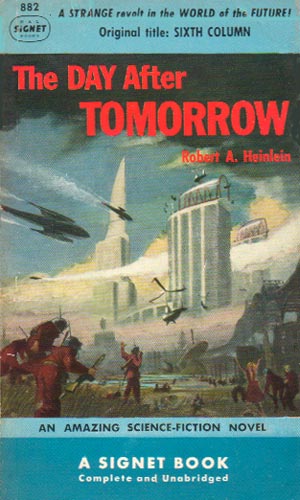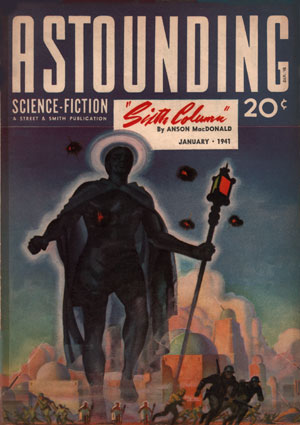Sixth Column
by Robert A. Heinlein
Astounding Science Fiction, January - February - March 1941
as by Anson MacDonald
substantially expanded for book editions —
Gnome Press, New York; 1949as by Robert A. Heinlein
256 pages
Signet, New York; 1951
as The Day After Tomorrow
Baen, Wake Forest, North Carolina; 2012
introduction by William H. Patterson, Jr.
afterward by Tom Kratman
The man at the television receiver said, "Shut up. We're listening," and turned up the volume. The announcer's voice blared out: "— Washington destroyed completely before the government could escape. With Manhattan in ruins, that leaves no —"There was a click as the receiver was turned off. "That's that," said the man near it. "The United States is washed up."
The United States overrun

Robert Heinlein wrote Sixth Column, his first full-length novel, before Pearl Harbor, while World War II was raging in Europe and before direct U.S. involvement. Somewhat prophetically, it's a Yellow Peril story, not specifically Japan, but a PanAsia war machine with high technology and great numbers of soldiers simply overwhelming us in a massive surprise attack. Only a handful of scientists in a hidden military laboratory are left with any chance of overcoming the PanAsians. Major Whitey Ardmore of Military Intelligence is sent to tell the personnel of the Citadel, as the lab is called, that they are released from superior command, to operate independently and continue to prosecute the war. He arrives just after an experiment gone awry has killed all but six of the Citadel's personnel. Shocked, he communicates the orders.
Colonel Calhoun, senior officer remaining:
Research versus the OccupationWhat the hell is there to do? Six men against four hundred million..... Maybe you don't get it. This is all the United States there is left. And it's left because the PanAsians haven't found it.
Ardmore, as senior line officer remaining, takes command. Directing the remaining scientists to continue research on the forces that had devastated the Citadel, he sends out a scout to see the extent of the PanAsian occupation. Jeff Thomas, the scout, a former hobo who stumbled across the Citadel by accident, travels around and returns. With him is an Asian-American farmer who had employed him several times, Frank Mitsui. The PanAsians wiped out Mitsui's entire family, and are systematically exterminating any American Asians they find. Mitsui first wanted to die, but now has promised himself vengeance. Jeff brings news of a country completely controlled, dominated almost to the point of slavery.
The scientists make tremendous progress with the Ledbetter Effect, the killing force now named after its deceased developer. Heinlein puts together a very plausible scientific explanation for the effect, mostly involving additional spectra analogous to light, with different effects as one moves through the spectrum. His characters discover that there are additional electromagnetic and gravitational spectra, and control of these means unlimited, almost magical powers, from weapons to transmutation of elements to gravity-control drives for vehicles. Frank Mitsui's appearance is fortuitous, because it appears that the weapon effects are selective depending on individuals, and the scientists think that there may be a racial grouping as well, allowing a deadly ray to kill PanAsians while ignoring other races. Their research has been hampered by the fact that they had no one of Asian blood to work with.
Ardmore soon finds that he has the weapons he needs to defeat the PanAsians, but not enough manpower and apparently no way to recruit under the controls imposed by the PanAsian masters. There cannot be a full confrontation under these conditions, so how best to use the forces available?
Beyond a fifth columnIt would have to be something like the "fifth columns" that destroyed the European democracies from within in the tragic days that led up to the final blackout of European civilization. But this would not be a fifth column of traitors, bent on paralyzing a free country, but the antithesis of that, a sixth column of patriots whose privilege it would be to destroy the morale of invaders, make them afraid, unsure of themselves.
And misdirection was the key to it, and art of fooling!
 The reference to a fifth column is not as topical as when Heinlein's novel first appeared. Shortly before, during the Spanish Civil War (1936-1939), Francisco Franco's army marched on Loyalist - Republican Madrid, with four columns. One of Franco's generals broadcast that the Fascists also had a "fifth column" inside Madrid, which would rise against the Loyalists as Franco's regular columns attacked from outside. So in Heinlein's science-fiction scenario, when American loyalists have no army left, and not even a fifth column of hidden revolutionaries, they must find some even more doubtful and irregular support, or manufacture it.
The reference to a fifth column is not as topical as when Heinlein's novel first appeared. Shortly before, during the Spanish Civil War (1936-1939), Francisco Franco's army marched on Loyalist - Republican Madrid, with four columns. One of Franco's generals broadcast that the Fascists also had a "fifth column" inside Madrid, which would rise against the Loyalists as Franco's regular columns attacked from outside. So in Heinlein's science-fiction scenario, when American loyalists have no army left, and not even a fifth column of hidden revolutionaries, they must find some even more doubtful and irregular support, or manufacture it.
After several alternatives have been discussed and discarded, Ardmore goes back over Jeff's report and finds the key: the only large gatherings of Americans permitted are for purposes of religion. The PanAsians have found through experience that it keeps the slaves quieter. Since the scientists have command of forces mysterious to the point of magic, why not found a new religion?
Heinlein discusses in some depth the possible reactions to a new religion, both from the PanAsian and American points of view. He works hard to reconcile the fake religion with the more orthodox ones to keep the consciences of the characters clear, and at the same time shows the touch of a true public-relations man in making the Cult of Mota, the new religion, showy and spectacular, even to the point of generating a halo over the heads of its "priests". The real meat of the book is here, in the spread of the new cult right under the PanAsians' noses. There are some great encounters, including one where Ardmore meets with the Prince Royal, the ruler of the conquered country. During Ardmore's visit (read "arrest") in his guise as High Priest of Mota, the Prince shows Ardmore a chess problem, asking how he would solve it. Ardmore moves a pawn and the Prince comments how unorthodox a move it is, but Ardmore replies that from there it is mate in three moves — doesn't the Master see?
Events progress rapidly and the final battle takes place. The Citadel men play on the PanAsian psyche by disgracing and ridiculing the individual governing PanAsians, and finally playing on fear and superstition by marching a giant projection of the God Mota through the streets, destroying PanAsians as it goes (see Astounding cover). The book ends with a confrontation between Ardmore and the Prince Royal and an absolutely great scene over the chess problem.
Shortly after Sixth Column appeared in Astounding, Heinlein said:
Campbell, Heinlein, and a futureDuring a period of racial insanity, mass psychoses, hysteria, manic depression, paranoia, it is possible for a man who believes in change to hold on, to arrest his judgment, to go slow, to take a look at the facts, and not be badly hurt. [...]
The important thing is to hang on to your sanity, to preserve sanity while it happens — no matter what bad things happen to the world. As individuals it may be difficult for us to do anything about it, even though all of us in our own ways, and according to our lights, are trying. But this series of wars that we find the world in now may go on for another five years, ten years, twenty years — it may go on for fifty years — you and I may not live to see the end of it.
I, personally, have hopes — wishful thinking — that it will terminate quickly enough so that I can pass the rest of my lifetime in comparative peace and comfort. But I'm not optimistic about it. During such a period, it is really difficult to keep a grip on yourself, but I think that we [science fictionists] are better prepared to than some of the others.
Robert A. Heinlein
"The Discovery of the Future"
Guest of Honor Speech,
Third World Science Fiction Convention
Denver, 4 July 1941Robert A. Heinlein
Requiem
edited by Yoji Kondo
This was the toughest review I've written to date. Heinlein has been an idol of mine since my pre-teen years reading his "juvenile" books, some of which are reviewed at Troynovant. Sixth Column is a long time favorite.
The basic ideas were given to Heinlein by Astounding's editor, John W. Campbell. It is a really plausible alternate future (as seen from 1940 and early 1941) to World War II as it actually developed after Japan attacked Pearl Harbor in December 1941. It's easy to give away too much of the plot, but frankly, the fun is in the scientific and character development, with a little dose of public relations and politics to spice it up. It is an absolutely incredible piece of work for the time, especially as a first novel.
After Sixth Column, Heinlein would not again accept hand-off story concepts, even from Campbell's fountain of ideas. Heinlein himself says in Expanded Universe that
Writing Sixth Column was a job I sweated over. I had to reslant it to remove racist aspects of the original story line. And I didn't really believe the pseudoscientific rationale of Campbell's three spectra — so I worked especially hard to make it sound realistic.
Robert W. Franson states elsewhere essentially that Heinlein started great and stayed that way. I firmly believe that this is the case, and that anyone considering reading Heinlein may do well to start with Sixth Column, or at least include it in their early reading.
© 2003 Ron Grube
Astounding January 1941 cover
by Hubert Rogers
Signet 1951 cover
by Stanley Meltzoff
The Baen edition (2012) of Sixth Column contains two quite interesting extras:
The introduction by Heinlein biographer William H. Patterson, Jr. relates the evolution of the story from Campbell's novella (which given Campbell's job as editor of Astounding he could publish neither in that magazine nor elsewhere), through providing the plot to Heinlein, Heinlein's writing of the novel-length serial, and the again-expanded book publication.
The afterword by Tom Kratman discusses Heinlein's presentation of the novel's still-controversial content, and why Heinlein made the content and style choices he did.
— RWF
| Troynovant, or Renewing Troy: | New | Contents | |||
| recurrent inspiration | Recent Updates | |||
|
www.Troynovant.com |
||||
|
Reviews |
||||
| Strata | Regions | Personae |
|
|||